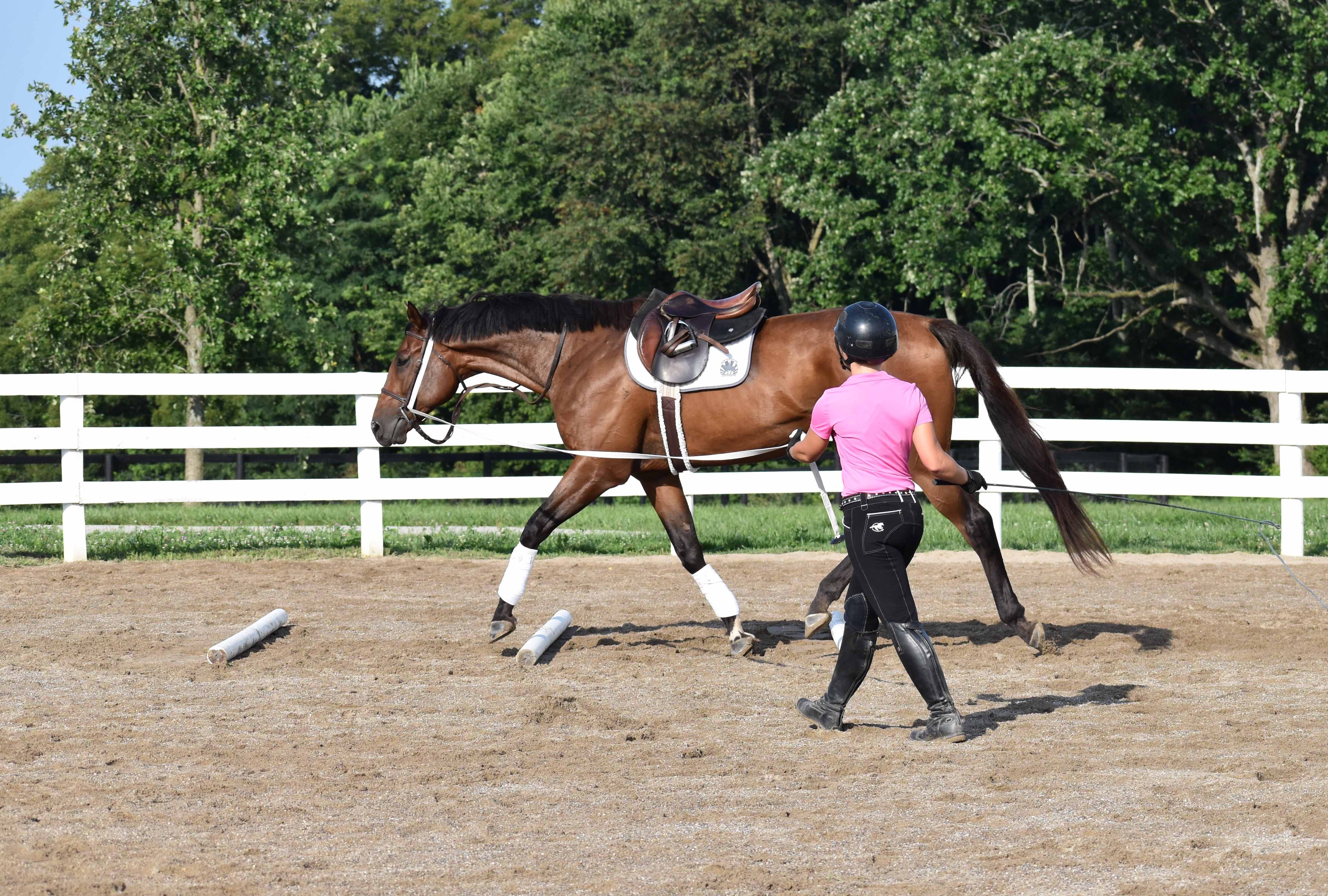This excerpt from Beyond the Track by Anna Ford with Amber Heintzberger and Sarah Coleman is reprinted with permission from Trafalgar Square Books (www.horseandriderbooks.com).
In this excerpt from Beyond the Track by New Vocations Racehorse Adoption Thoroughbred Program Director Anna Ford, we learn how to best start the OTTB over ground poles in preparation for jumping.
You can introduce the horse to ground poles under saddle or on the longe line. At this point, some horses may be brave and balanced enough, and their riders secure enough, to approach a ground pole (or poles) under saddle. At New Vocations, I generally prefer to longe horses over them first. Not only is it safer for the rider, enabling him to gauge the horse’s reaction from a distance, but it also eliminates “interference” from the rider’s hands and legs, giving the horse freedom to use his body as he learns to navigate the poles.
As applies to every phase of a young horse’s training, the introduction to ground poles requires patience from the handler and rider. Though it takes more time to go step-by-step—never rushing or pushing the horse—your patience will pay off with a calm, confident, and better-educated horse. If you rush him you will build a weak foundation that cracks under the pressure as training becomes more complex.

Longeing
Prepare the ring ahead of time for your first ground pole lesson. The poles can be “lying around” as you warm up to allow the horse to get used to them. I find it helpful to have a ground person on hand to set up the poles when the horse is ready to work.
I recommend a “heavy” cotton longe line for longeing your horse over ground poles. I find the thin, nylon styles are too lightweight and tend to flap around.
You should warm up the horse with his usual routine before you start schooling the ground poles. Five or ten minutes should be sufficient. He should be relaxed, but not overtired. If he is excited he will be less receptive to your commands; if your horse has already worked hard, it might be overwhelming to introduce something new—call it a day and wait until the next lesson.
Starting with a Single Pole
Place a single ground pole on a longe circle. Shorten the line and lead the horse over to the pole. Allow him to look at it and sniff it, then ask him to step over. Each horse reacts differently to seeing poles on the ground. Some of them step right over a single pole without a second thought, while others will spook at the pole and not want to go near it. Walk over the pole in one direction, then turn around and walk back over it. Once he is willing to walk over it in both directions with you accompanying him, put him on the longe circle and let him walk and trot over it by himself.
Adding Poles
Once your horse is happily longeing over a single ground pole at the walk and trot, add more poles, spacing them about 4 to 5 feet apart, depending on your horse’s length of stride. They should be evenly spaced on a straight line—you may have to move with your horse and alter the shape of the longe circle to accommodate them. I have found that some horses try to jump over two poles, thinking a ditch lies between them, so moving from one to three poles is often the better transition (a horse is less likely to try to jump three poles at once). Adjust the poles if the distance between them seems uncomfortable for your horse, and add or take away poles to make the exercise more or less difficult.
Adding Canter
Only ask your horse to canter over ground poles once he is confident and relaxed trotting over them. Canter poles should be introduced in the same way, beginning with a single pole. Start by trotting the horse over the pole several times until he is relaxed, then ask him to canter over it.
The horse’s first reaction may be to jump the pole; be sure to move with him if he does. Practice going over the single ground pole until the horse does so quietly, then add additional poles. Canter poles should be spaced 9 to 12 feet apart depending on the length of the horse’s stride, but in the beginning, I like to space the poles an extra stride apart, say 18 to 24 feet (curving with the longe circle), to give the horse more room to figure the exercise out.
Under Saddle
I recommend longeing your OTTB over ground poles until he is obediently walking, trotting, and cantering over them—and only then adding a rider. With OTTBs, it is important to have a secure seat and be able to follow the horse’s motion no matter what he is doing underneath you. An inexperienced horse may jump over the poles or take erratic steps when he is starting out, and an insecure rider may find it difficult to maintain a balanced position. Sitting heavily on the horse’s back or hanging on his mouth accidentally will make him apprehensive about the poles and cause difficulty as your schooling progresses.

Pick up your copy of Beyond the Track from Trafalgar Square Books HERE!
